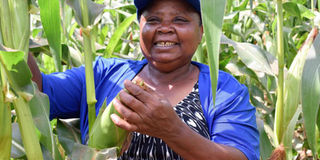Farming smart to raise farm output

Ruth Muthoni of Murang’a is assured of a bumper harvest thanks to conservative farming. PHOTO | LEOPOLD OBI | NATION MEDIA GROUP
What you need to know:
- Mulching helps preserve the soil’s moisture, enabling crops thrive even with little rainfall.
- Maize grown using mulching is much bigger than that grown conventionally.
- Mechanisation is the surest way of improving yields.
After getting nothing from her five-acre farm last year due to prolonged drought, Ms Ruth Muthoni decided to try an alternative farming technique.
“I now practice conservation farming,” she said. “Basically, conservation agriculture uses mulching, and I don’t plough my farm.”
That crops can give high yields on untilled land full of weeds might seem odd, but a number of studies conducted around the world have shown positive feedback from the practice.
SMART FARMING
Ms Muthoni said all you need is a hoe or cutlass for digging holes in which to plant the seeds and using a planting line to ensure that you have the correct spacing.
After digging the holes, you add manure and fertiliser to the soil before planting and covering the seeds.
Thereafter, you cover the soil with mulch, which can be dry plant leaves, grass, banana leaves or maize stocks.
Ms Muthoni and 200 other farmers in lower Murang’a were introduced to, and trained on, the “smart farming” technique by the Canadian Food Grain Bank in partnership with the Anglican Development Service (ADS) with the aim of enhancing food production.
BUMPER HARVEST
When DN2 visited Ms Muthoni’s farm recently in the company of government officials and conservation farming crusaders, we were greeted by acres of robust, shoulder-high maize on a two-acre plot.
An ecstatic Ms Muthoni was optimistic of a bumper harvest after several months of poor yields.
She said that since mulching is labour-intensive, she will farm the remaining three acres one season at a time.
“Maize grown using mulching is much bigger than that grown conventionally. In fact, most of the maize grown conventionally does not even have cobs,” she said.
MULCHING
Mulching helps preserve the soil’s moisture, enabling crops thrive even with little rainfall.
Residues on the soil surface reduce the splash effect of raindrops, resulting in higher infiltration and reduced surface run-off.
Jim Cornelius, the Executive Director of the Canadian Food Grain Bank, says the organisation has donated $14 million (Sh1,442,000) to promote conservation agriculture in five counties in Kenya, namely Busia, Machakos, Makueni, Kitui and Murang’a.
“The programme aims at training more than 50,000 farmers in the counties on conservation agriculture in the next five years,” he said.
Meanwhile, Godfrey Githinji, an agronomist and project officer at ADS who has been working with the farmers in Murang’a, says the thickness of the mulch does not matter since mulching is a continuous process.
“As the mulch remains on the farm, it decomposes and decreases, so a farmer has to keep adding some to ensure the soil remains covered,” he said.
KITCHEN GARDEN
In Mwala, Machakos County, Juliana Musuki grows Chinese cabbages and arrowroots in shallow pits behind her two-bedroom house.
She waters them twice a week.
Ms Musuki’s garden holds about 100 heads of Chinese cabbage.
“My kitchen garden has freed me from buying vegetables,” said the mother of five. “But more importantly, what we consume is fresh and healthy.”
Growing vegetables in bags or pits was introduced to farmers in Eastern Kenya by Farm Input Promotions Africa (FIPS-Africa) to build the farmers’ resilience against climate change
FOOD SECURITY
A kitchen garden plays a critical role in ensuring household nutrition, besides complementing other farm produce.
Indeed, the Food and Agriculture Organisation says kitchen gardens have great potential for improving household food security and alleviating micronutrient deficiencies.
Gardening can enhance food security through direct access to a diversity of nutritionally-rich foods, increased purchasing power from savings on food bills and income from sales of garden products, and fall-back food provision during lean periods.
Peter Mwinzi, another Chinese cabbage farmer, explains that to grow the vegetables, you dig a pit measuring 3 x2 x2 ft.
“While digging, the top soil and sub-soil are put separately. The sub-soil is then returned into the pit, after which a polythene sheet is laid to cover the bottom and walls of the pit,” he says.
The top soil is mixed with livestock manure then returned to the pit, and the vegetables planted on it.
This ensures that water is retained in the soil for a long time.
CONSULT
Factors such as soil fertility and quality of seeds remain critical, so it is advisable to consult agricultural experts.
That is what Daniel Maroko, 28, did, before he began potato farming less than two kilometres from Narok Town.
On the advice of the Crop Nutrition Laboratory Services, an agricultural consultancy firm, he took a soil sample from his nine-acre farm for analysis.
“The agronomists gave me fertilisers, but also recommended I add animal manure,” he said.
He then bought the recommended seed varieties from the Kenya Agricultural and Livestock Research Organisation in Molo.
He harvested more than 300 90-kg bags, and the tubers were also sizeable.
RETURNS
Mr Maroko said he spent about Sh300,000 on the whole project, including acquiring the land, but adds that the returns he has made are incomparable to the cost.
On average, an acre produces three to six tonnes of potatoes in the country, which is quite low compared to Europe and Asia, where farmers get up to 20 tonnes per acre, according to potato experts.
Several factors contribute to this poor performance, including sub-standard seeds, low level of mechanisation and poor use of fertilisers, experts say.
Mechanisation is the surest way of improving yields, as seen among farmers who have embraced the practice, as well as use high quality seeds and the right fertilisers.





